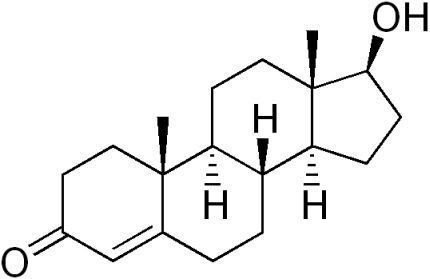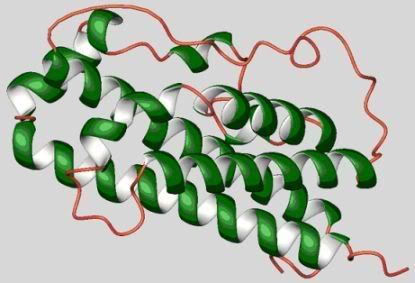
Molecular Structure of Testosterone
Testosterone (T) – perhaps one of the most important hormones for bodybuilding, or at least, one of the most common hormones in the human body. T is a primary sex hormone in men, and also highly anabolic. It is also found in women, but to a much lesser degree than men, men create, on average, twenty to thirty more times T than women.
Since T is highly anabolic, this means that it plays a role in “building of”, usually tissues in the body, ie. muscle mass. T also plays a role in protein synthesis which helps you repair muscle after an intense workout. Other anabolic effects with T is strength gain, this is fairly obvious, the more muscle mass you have, the heavier you can lift.
T is a steroid hormone, and like all other steroid hormones cholesterol is one of the precursors for its production. Most of the T in men is made in the testes, but also in smaller quantities in the adrenal cortex, which is found on top of the kidneys. In women, most of the T is synthesized in the ovaries.
In addition to its large role on muscle tissue synthesis, T indirectly affects muscle fiber’s protein content by promoting growth hormone release, which leads to insulin growth factor (IGF) synthesis and release from the liver. T also influences neural receptors to increase neurotransmitter release and initiate structural protein changes that alter the size of the neuromuscular junction, the gap between the pre-synapse and the cellular membrane of the muscle cell. These neural effects increase the force-production capabilities of skeletal muscle, thus more strength.
Luteinizing Hormone (LH) and Follicle-Stimulating Hormone (FSH)
These two hormones are gonadotropic hormones; a hormone released either from the anterior pituitary gland, which is found in the brain. FSH in males stimulates gernminal epithelium growth in the testes to promote sperm devolvement. LH also stimulates the testes to secrete T.
How exercise affects FSH and LH is still unknown, here are inconsistent reports that describe short-term exercise-association release. However, LH release works like a pulse; it has it peaks and low points, thus making it somewhat difficult to separate any specific exercise related changes from a normal pattern. But generally, LH concentration rises before exercise and peaks during recovery.
Growth Hormone, Exercise, and Tissue Synthesis
Growth hormone is a 191 amino acid, single chain polypeptide hormone, which is synthesized, stored and secreted by the cells within the anterior pituitary gland, which stimulates growth and cell reproduction.

Structure of Human Growth Hormone
Short term physical activity stimulates a sharp rise in GH pulse amplitude and the amount of hormone secreted per pulse. More importantly though, exercise stimulates release of GH isoforms with extended half-lifes as compared to normal GH, this will allow for the effects of GH to last longer on target tissues. Some of the most GH release benefits include muscle, bone, and connective tissue growth and remodeling. It also influences the choice of “fuel” during exercise, principally decreasing glucose uptake, increasing free fatty acid mobilization and enhancing liver gluconeogensis (the creation of glycogen). The net metabolic effect on increased exercise-induced GH production preserves plasma glucose concentration for central nervous system and muscle functions. Many of the growth-promoting effects of GH result from actions of an intermediary chemical messenger on different target tissues, rather than direct effect of GH itself. These peptide messengers, produced in the liver, are termed somataodmeials or insulin-like-growth factors because of there similar structure to insulin. These factors exert potent peripheral effects on the motor units of other tissues.
The mechanism on how exercise stimulates GH release to improve protein synthesis, and thus muscle hypertrophy (muscles growing in size), and it’s other effects is unknown. One hypothesis says that exercise directly stimulates GH release, or release of somatomedians from the liver or kidneys, which then in turn stimulates anabolic processes. Exercise also may indirectly affect GH by stimulating the cholinergic pathways to trigger GH release.
Trained and sedentary individual show similar increases in GH concentration when they exercise to exhaustion. In contrast though, the sedentary person maintains higher levels of GH for several hours into recovery. During a standard bout of sub-maximal exercise, sedentary individuals have a greater GH response. Because this absolute sub-maximal exercise level represents greater stress for the less fit person. GH release generally relates more to the relative strenuousness of physical effort.
Insulin-Like Growth Factors (IGF)
IGF’s mediates many of GH’s effects. In response to GH simulation, liver synthesize IGF-1, a 70-amino acid poly peptide and IGF-II (a 67-amino acid polypeptide, the total time for this process that requires 9 – 30 hours. IGF’s travel in the blood attached to one of five types of binding proteins for release as a free hormone to interact with specific receptors. The factors that influence IGF transport include the binding proteins within muscle, nutrition status and plasma insulin levels.
The time required for IGF synthesis to GH stimulation affects any IGF appearance during or immediately following exercise. This suggest that it’s release results from disruption of cells already containing IGF. Also, GH-mediated release of IGF with exercise may reflect a different time course than the typically observed in non-exercise conditions.
Kurt Kuhn - www.FUSIONBodybuilding.com


No comments:
Post a Comment